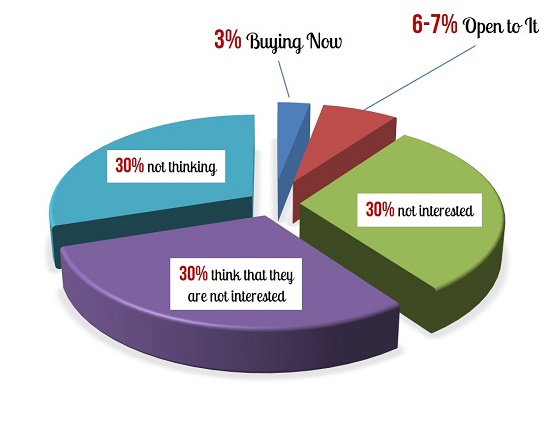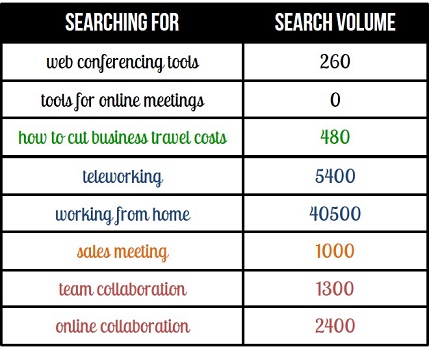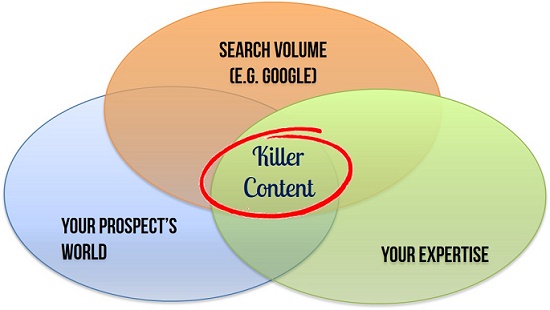How do you attract new prospects today? Many companies we work with do one or more of the following.
They do cold calling, go to networking events and visit trade shows. The challenge with these face-to-face interactions is that they are difficult to scale. In addition, after a successful event, you are left with a stack of business cards. You focus your limited time on hot contacts, people who showed real interest. The others will soon forget all about you.
Most companies also spread information about themselves and their services via their website, newsletters and social networks. This approach certainly helps creating the awareness about the company and its products and services, but suffers two major problems:
Problem #1: This communication only targets a small number of prospects. Prospects that are ready to buy, aware of the type of service you offer and the terminology you use to describe it. According to the aforementioned study of Chet Holmes, only 3% of all potential prospects are actively buying.

Problem #2: This is a one-size-fits-all approach. There are different types of prospects, and they are all in different phases of a buying process. Spreading the same message to everyone is not an effective strategy.
Let me illustrate this with an example. GoToMeeting by Citrix allows companies to host online meetings and webinars. Their customers include small business, freelancers and companies with offices in multiple locations, or with employees who work remotely. A small number of their prospects may effectively be searching for “tools for online meetings” or “web conferencing tools”. Below are the search estimates provided by Google Keyword Planner tool (the number of monthly searches of these terms).
But what about managers thinking about cutting down travel expenses? Or those that allow their employees to work from home? Or sales reps looking for the best way to prepare a remote sales meeting? Or simply team managers pondering how to make their geographically distributed team members collaborate more effectively?

They are all potential customers of GoToMeeting. The trouble is, they may not be thinking of GoToMeeting.
And guess what? GoToMeeting has thought of these prospects too. They have something for everyone:
- A story about a company that not only has their employees working from home, but have successfully abandoned the office completely
- Articles on better collaboration
- Preparation of sales meetings
- And even an attractive infographic on how to be more productive during winter months!
Why is Citrix doing this? Because most prospects are not searching for information about your company and your products. They are searching for content that will help them deal with their problems or achieve their goals.
Here is what this means for you.
Instead of just communicating about your business and your products, you need to spend as much time – if not more – creating, curating and sharing content useful to to your prospects. The best topics are found in the intersection between (1) your expertise, (2) the worldview of your prospects (their job, problems and goals) and (3) what people are actually searching for online.

By spreading these topics via your website, social networks and email, you will attract a much larger number of prospects. And if you do that in a non-salesy way, you will increase the chance of prospects actually liking and even sharing your content.
Even better, you will start branding yourself as an expert in your prospect’s mind.
Does this only impact your online communication?
Not at all. By turning your best content into presentations, you will become interesting to wider audiences on events and conferences. Besides, remember that stack of business cards you collected at an event? Even if they are not ready to buy, most of them will likely benefit from content you create, allowing you to stay top of their mind until they are ready to buy. In day 3, we will show you how to do this without spending much time.
This is a long term strategy that will allow you to build a community of prospects that give you permission to market to them.
But what if you want quick results?
You can start attracting new prospects as early as today using paid ads. Here is how you can supercharge your start using Google AdWords.
Lots of people don’t even consider this step, or just throw some money on visits to their unoptimized website and conclude it was a waste.
However, done right, this step can save you loads of time and provide invaluable information. Google AdWords can be the quickest and most effective way to:
- Attract relevant prospects within hours
- Start learning which of their problems – or your USPs – different prospects care most about. By crafting different ads with different messages, and letting Google rotate them, you will quickly see where which prospects click the most
- Uncover what prospects are really searching for, and start segmenting your audience
The way we like to do this is carry out a series of rapid iterations – just 1 or 2 days each, spending no more than a couple of hundred bucks, and improving every time until the leads start flowing in.
This way you get a tremendous learning value, and the super-fast iteration opportunity. And if the cost is right, Google AdWords may just prove to be a very effective way to quickly grow your business.
Remember, you are not your customer. You cannot know what will work before you try it. I recently earned 17500 euros more on sales of my apartment thanks to Google AdWords. Everyone thought I was crazy to spend 500 euros on attracting buyers to a website with a single apartment on it.
Warning: you may not have great results if you bring your prospects to an informational site. Many companies are competing for a share of your prospects mind. Your prospects are busy and have learned to ignore commercial messages. They don’t really care about your company and products. They want solutions to their problems, stuff that will make them feel or work better.
***
Have a look at your website and be brutally honest with yourself. Is your website about your company and products, or is it made to help your prospects? Now, in Google search, type in “site:<domain name of your website>” (e.g. site:example.com). Study the titles and descriptions. Will they easily attract attention of different types of prospects in different phases? Don’t worry, we’ll show you how to fix those headlines already tomorrow.
That’s all for today. Getting visitors to your website is just a first step. Tomorrow we’ll look at how you can turn anonymous visitors into interested prospects.